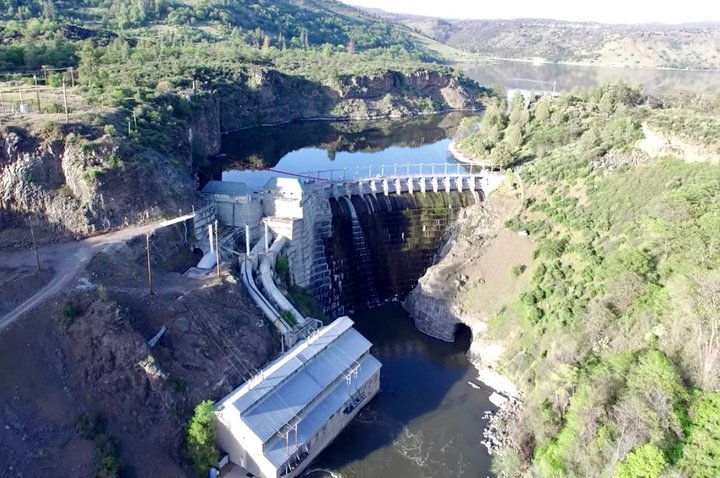
Copco No. 1 dam. | Screenshot from video by Klamath River Renewal Corporation.
###
PREVIOUSLY: Feds Approve Partial Transfer of Ownership of Four Hydroelectric Dams on the Klamath
###
With a historic Klamath River dam removal agreement in jeopardy, California Governor Gavin Newsom has reached out to billionaire financier Warren Buffett, imploring him to salvage the deal.
In an impassioned letter sent Wednesday, Newsom said the dams have devastated salmon runs, sickened the river and caused suffering among Native American tribes in the Klamath basin. “The Klamath River dam removal project is a shining example of what we can accomplish when we act according to our values,” his letter reads.
The four hydroelectric dams on the lower Klamath are owned by Oregon-based utility company PacifiCorp, which is a subsidiary of Buffett’s multinational conglomerate Berkshire Hathaway. Like many energy companies in the United States, PacifiCorp wants to divest itself from the expense and liability of managing aging dams.
In 2016, the company and other stakeholders entered into an agreement to transfer ownership to the Klamath River Renewal Corporation (KRRC), a nonprofit set up explicitly to take over the federal license and oversee the dams’ removal. The $450 million endeavor would constitute the largest river restoration project in American history. As the Sacramento Bee reported, “PacifiCorp customers in Oregon and Northern California have contributed $200 million to the project, through surcharges on their bills, while the state of California pledged $250 million in funds from Proposition 1, a voter-approved 2014 water bond.”
On July 16, however, the Federal Energy Regulatory Commission (FERC) delivered a curveball, agreeing only to only a partial license transfer. In its ruling, the commission reasoned that KRRC “has limited finances and no experience with hydropower dam operation or dam removal [while] PacifiCorp has additional resources as well as experience.
“Accordingly,” the ruling continued, “we believe that the public interest requires that PacifiCorp remain a co-licensee, and we condition our approval of the transfer upon it doing so.”
The array of environmental, tribal and fisheries entities that have been fighting for dam removal reacted to the ruling with cautious optimism. Karuk Chairman Russell ‘Buster’ Attebery, for example, said, “We can work with this.” And S. Craig Tucker, a natural resources consultant with the Karuk Tribe, said, “FERC just showed us the path to dam removal.”
PacifiCorp’s reaction was more muted. It released a statement following the FERC ruling saying the company would “fully examine the order and will consult with our settlement partners to assess its impact on continued implementation of the Klamath Hydroelectric Settlement Agreement [KHSA].”
A week ago, PacifiCorp’s chief legal officer sent a letter notifying fellow signatories to that agreement that it plans to take advantage of section 8.11, which is the agreement’s “termination” clause.
Speaking to the Outpost today, PacifiCorp spokesman Bob Gravely said this doesn’t necessarily mean that the deal is null and void.
“We’re committed to finding a way to fix the agreement,” he said. But he acknowledged that FERC’s refusal to transfer the license cleanly threw a wrench in the works. “The protections for PacifiCorp’s electricity customers were based on the license transferring to a third party,” Gravely said.
He described the company’s invocation of the termination clause not as an attempt to get out of the agreement but rather as “triggering the ‘meet and confer’ provisions.”
Tucker, the Karuk consultant and a key negotiator in the agreement, is frustrated by this turn of events. “We can’t just keep talking,” he said. “We actually have to get to dam removal. This has been going on for years. We worked with PacifiCorp to get legislation and California water bond money to make this possible. It’s time that we removed the dams.”
Newsom’s letter, addressed to Buffett and other executives from Berkshire Hathaway and Pacific Power, makes the same argument.
“PacifiCorp and its ratepayers will benefit from this publicly funded dam removal when compared with a lengthy and costly process to relicense these outmoded dams under complex federal regulations,” it states.
In an apparent reference to the ongoing protests over the killing of George Floyd and corporate responses to that movement, Newsom’s letter describes dam removal as a matter of social justice:
Your personal leadership on behalf of this remarkable environmental and cultural restoration is essential at a moment when other investor-owned corporations are standing up to redress historical inequities.
If we are serious about addressing the needs of the historically dispossessed, it is up to us to listen, respond and make meaningful sacrifices to create a more equitable California. Tribal communities have been advocating for these changes for decades. Now, we must take this opportunity to respond by expediting the process to remove these dams.
Earlier today, PacifiCorp President and CEO Sefan A. Bird sent a response letter to Gov. Newsom. (It’s unclear whether Newsom’s letter ever reached Buffett.) The statement says the company is committed to solving cultural and community impacts, but it stops short of committing to dam removal:
While FERC’s ruling contemplates a path forward for dam removal, it does so at the expense of the amended KHSA’s customer protection framework. And while much progress has been made to date, FERC’s order and the negotiated amended KHSA cannot be easily reconciled.
The target date for dam removal has been 2022. But with PacifiCorp balking at FERC’s demand that it remain a co-licensee, that prospect now seems unlikely, and the two sides appear to be at an impasse.
CLICK TO MANAGE